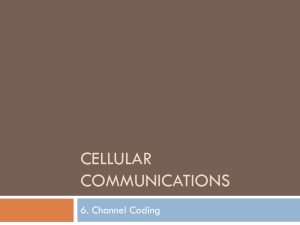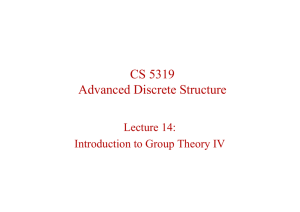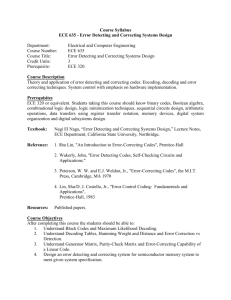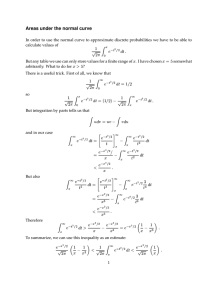Lecture 2: Error Correction and Channel Noise
advertisement
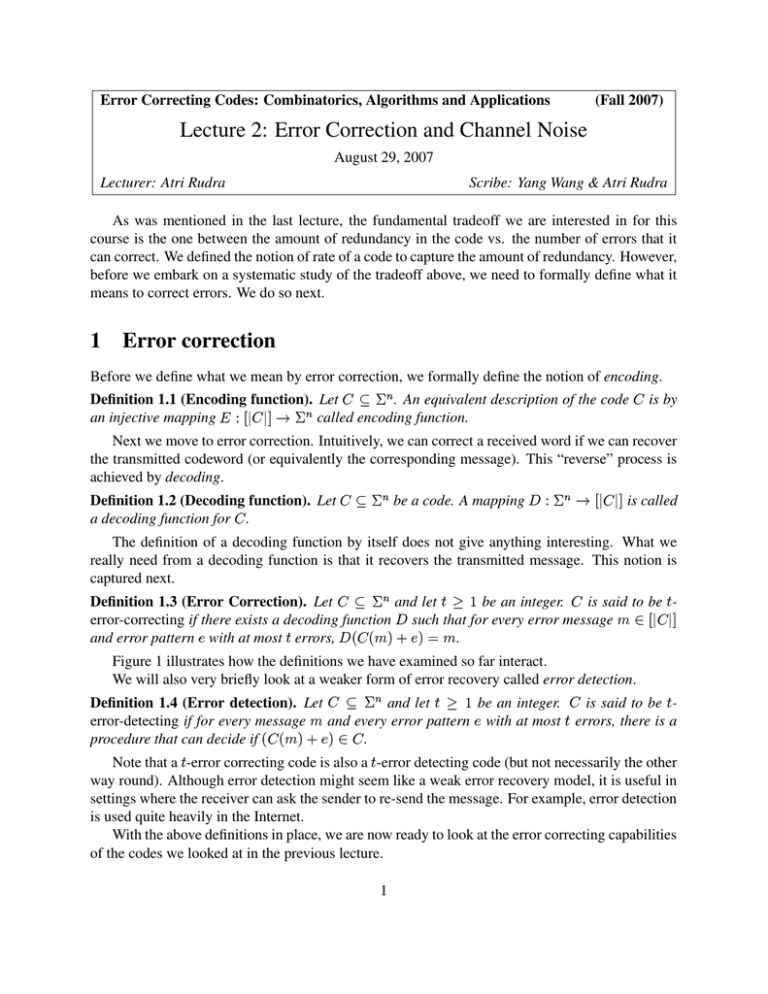
Error Correcting Codes: Combinatorics, Algorithms and Applications
(Fall 2007)
Lecture 2: Error Correction and Channel Noise
August 29, 2007
Lecturer: Atri Rudra
Scribe: Yang Wang & Atri Rudra
As was mentioned in the last lecture, the fundamental tradeoff we are interested in for this
course is the one between the amount of redundancy in the code vs. the number of errors that it
can correct. We defined the notion of rate of a code to capture the amount of redundancy. However,
before we embark on a systematic study of the tradeoff above, we need to formally define what it
means to correct errors. We do so next.
1
Error correction
Before we define what we mean by error correction, we formally define the notion of encoding.
Definition 1.1 (Encoding function). Let
. An equivalent description of the code
an injective mapping
called encoding function.
is by
Next we move to error correction. Intuitively, we can correct a received word if we can recover
the transmitted codeword (or equivalently the corresponding message). This “reverse” process is
achieved by decoding.
Definition 1.2 (Decoding function). Let
a decoding function for .
be a code. A mapping
is called
The definition of a decoding function by itself does not give anything interesting. What we
really need from a decoding function is that it recovers the transmitted message. This notion is
captured next.
! "$#%&"(')
and let
be an integer.
is said to be Definition 1.3 (Error Correction). Let
error-correcting if there exists a decoding function such that for every error message
and error pattern with at most errors,
.
Figure 1 illustrates how the definitions we have examined so far interact.
We will also very briefly look at a weaker form of error recovery called error detection.
*
+,
! "$#%&"-
Note that a -error correcting code is also a -error detecting code (but not necessarily the other
Definition 1.4 (Error detection). Let
and let
be an integer.
is said to be error-detecting if for every message and every error pattern with at most errors, there is a
procedure that can decide if
.
way round). Although error detection might seem like a weak error recovery model, it is useful in
settings where the receiver can ask the sender to re-send the message. For example, error detection
is used quite heavily in the Internet.
With the above definitions in place, we are now ready to look at the error correcting capabilities
of the codes we looked at in the previous lecture.
1
channel
m
C (m)
y = C (m) + e
enco d ing functio n
m
d eco d ing functio n
e
Figure 1: Coding process
2
Parity and Repetition codes
In the last lecture, we looked at examples of parity code and repetition code, with the following
properties:
/. 102'4365879'):5<;='4>65@?'):BAC>6D
-EGF HJIK 102'3B5L7M'N:O5G;='PQ365@?'PRATS6D
U+WV&XY5ZT[B\^]
We will start with the repetition code. To study its error correcting capabilities, we will consider
the following natural decoding function. Given a received word
, divide it up into four
consecutive blocks
, where every block consists of three bits. Then for every block
(
), output the majority bit as the message bit. Now we claim that this decoding function
can correct any error pattern with at most error. This is easy to verify. For example, if a block of
is received, we know the original message bit should be because there are two s. In other
words, we have argued that
c bNd-bN:
XYeX
!U \ 5GU ] 5<U E 5<UT_Z"
X
Ua`
X
/EGF HJIK is a -error correcting code.
fEgF HJIK cannot correct 3 errors. For example, if both the
However, it is not too hard to see that
errors happen in the same block and a block in the received word is X6eX then the original block
in the codeword could have been either Ca or XaXaX . Thus no decoder can successfully recover the
transmitted message in this case. (Recall we are assuming that the decoder has no side information
about the transmitted message.)
hEGF HJIK code: it can correct Thus, we have pin-pointed the error correcting capabilities of the
Proposition 2.1.
error but no more. However, note that the argument assumed that the error positions can be located
arbitrarily. In other words, we are assuming that the channel noise behaves arbitrarily (subject to
a bound on the total number of errors). Obviously, we can model the noise differently. We now
briefly digress to look at this issue in slightly more detail.
2.1 Digression: Channel Noise
As was mentioned above, until now we have been assuming the following noise model that was
studied by Hamming [2]:
2
Any error pattern can occur during transmission as long as the total number of errors
is bounded. Note that this means that the location as well as the nature 1 of the errors
are arbitrary.
We will frequently refer to Hamming’s model as the Adversarial Noise Model.
We could also have following error model.
-EgF HJIK
S
No more than error can happen in any contiguous bit block.
First note that for the channel model above, no more than 4 errors can occur when a codeword in
is transmitted. Second, note that the decoding function that takes a majority vote in each
block, can always successfully recover the transmitted codeword for any error pattern (while in the
worst case noise model it could only correct at most error). This channel model is admittedly a bit
contrived but it illustrates the point that the error correcting capabilities of a code (and a decoding
function) crucially depends on the noise model.
An alternate way to model the noise than Hamming’s way is to model the channel as a stochastic process. As a concrete example, we briefly mention the binary symmetric channel with crossover
, denoted by
which was first studied by Shannon [1]. In this model
probability
when a (binary) codeword is transferred through the channel, every bit flips independently with
.2
probability . We note that we only need to consider in the range
Note that the two noise models proposed by Hamming and Shannon are in some sense two
extremes: Hamming’s model assumes no knowledge about the channel (except that a bound on
the total number of errors is known) while Shannon’s noise model (for example
) assumes
complete knowledge about how noise is produced in the channel. In this course, we will consider
only these two extreme noise models. In real life, the situation sometimes is in the “middle.” If you
are interested in such channels, one such hybrid model called Arbitrary Varying Channel is one of
the suggested project topics.
i
kl mK
X bNijb
f.
XYeXCXY
i
f.
nXY5ZRAC3&
kl oK
6X eXaXaX
XYeXaXCX
and look at its error correcting capabilities in the worst case noise
We now return back to
model. We claim that
cannot correct even one error. Suppose
is the received word,
then we know that an error has occurred but we do not know which bit was flipped. The two
codewords
and
can both give rise to the received word
when exactly one bit has
been flipped. As we are assuming that the receiver has no side information about the transmitted
codeword, no decoder can know what the transmitted codeword was.
XaXaXaXaX
References
[1] Claude E. Shannon. A mathematical theory of communication. Bell System Technical Journal,
27(2):379–423 and 623–656, July and October, 1948.
q
s t
1
pgqQrgs8rutZv
For binary codes, there is only one kind of error: a bit flip. However, for codes over a larger alphabet, say
,
being converted to a or are both errors but are different kinds of errors.
2
for every
. Then for any
, just flip the bits of
Assume we could do error-correction on
the received word and then we can assume that the channel is the
, which by our hypothesis, we can already
handle (as
).
s$
}~s@Lt
wxy{z
q/|cw}~x|ysg^LQtz
3
}~s@Lt
[2] R. W. Hamming. Error Detecting and Error Correcting Codes. Bell System Technical Journal,
29(2):147-160, April, 1950.
4
